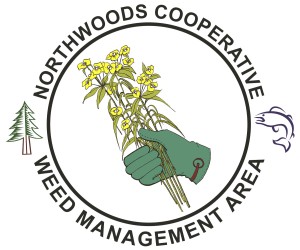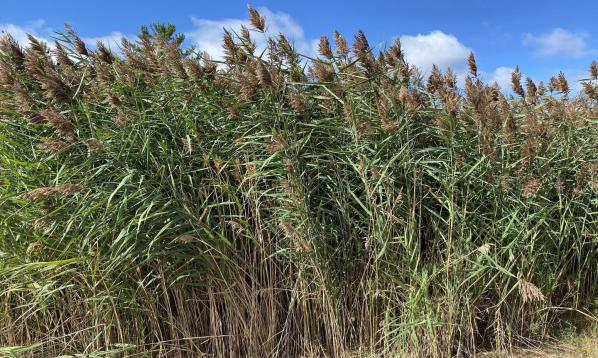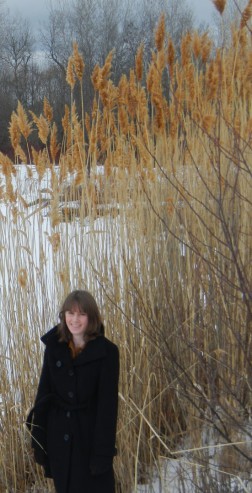Phragmites or Common Reed
(Phragmites australis)
In Wisconsin, there are two main forms of phragmites (common reed): native phragmites (Phragmites australis ssp. americanus) and invasive phragmites (P. australis ssp. australisus). Native phragmites is a less aggressive plant and does not generally takeover wetlands. Invasive phragmites is extremely aggressive and can takeover wetland areas and shorelines of waterbodies like lakes, streams, and rivers. Invasive phragmites grow in dense monocultures that expand and crowd out other species, decreasing plant diversity and deteriorating the habitat for wildlife.
Invasive phragmites is well established in parts of southeastern Wisconsin and has become very problematic along the shores of Lake Michigan. In northwestern Wisconsin and along the shores of Lake Superior, invasive phragmites is not well established. The Great Lake Indian Fish and Wildlife Commission (GLIFWC) has been diligently surveying for and treating invasive phragmites in the NCWMA region of northwestern Wisconsin for many years. The treatments have been working. In 2023, they found no invasive phragmites at 73% of the sites that they surveyed. They treated the 26 sites where invasive phragmites were found.
The two subspecies of phragmites can look very similar. Being able to correctly distinguish invasive and native phragmites is essential for managing infestations. Below are a few resources to help distinguish the two subspecies of phragmites. If a population has unusual characteristics, a genetic analysis of plants samples can be used to determine if it is native, invasive, or a hybrid. Hybrids could have the potential to spread invasive characteristics into native populations.
Phragmites Resources:
-
GLIFWC has created a map of sites verified as native phragmites and invasive phragmites. This helps so that organizations are not reanalyzing the identification of sites repeatedly. Here is a link to GLIFWC’s Phragmites Maps.
-
A recent article in Invasive Plant Science and Management compared different characteristics that can be used to distinguish the native and invasive phragmites. It gives a checklist of five best traits including stem spot fungus (on native plants), stem color, leaf retention, ligule base height, and lower glume length/leaf length: Morphological traits for rapid and simple separation of native and introduced common reed (Phragmites australis)
-
Here is a great photographic guide to distinguish plants: Minnesota Non-native Phragmites Early Detection Project Guide to Identifying and Reporting Non-native Phragmites australis by Julia Bohnen
Citation: Pandian, Vijai and Renz. Mark (2011). UW Extension. Available at: hort.extension.wisc.edu/articles/invasive-phragmites/
Identification
- Very tall reed, reaching up to 15 feet tall.
- Plants grow in dense stands with a thick mass of rhizomes in the soil.
- Inforescences are on large purplish plumes (7-15”) at the top of plants.
- Leaves are bluish-green, narrow, and up to 2 feet long.
- Stems are rough, dull (not shiny), and green. (Native species have smooth, shiny, reddish stems.)
- Long white hairs at leaf sheath. Leaf sheaths are tight on the stem even in winter. (Native species have leaf sheaths that fall off in winter.)







